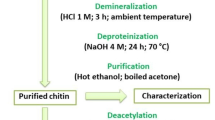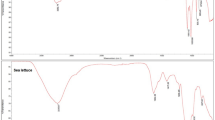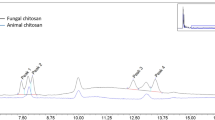Abstract
Chitosan and chitooligosaccharides were extracted from white-leg shrimp shells by chemical treatment. Low molecular weight (13 kDa) and a high degree of deacetylation (54.83%) in chitooligosaccharides led to high water solubility compared to chitosan. Antimicrobial assays indicated that chitosan and chitooligosaccharides exhibited marked inhibitory activity against food-borne pathogenics, spoilage bacterial, and fungal strains tested. However, chitooligosaccharides revealed greater inhibitory effects than chitosan on tested microorganisms. The substitution of flour by chitosan or chitooligosaccharides in bread formulation (1 g/100 g total weight basis) showed antimicrobial effects against Bacillus cereus and Rhizopus sp. growth. Also, the fruity odor in bread containing chitosan or chitooligosaccharides was delayed. Interestingly, the bread containing chitooligosaccharides showed a stronger inhibitory effect against B. cereus and Rhizopus sp. compared to bread containing chitosan and control, where B. cereus and Rhizopus sp. were observed growing on the surface of bread after 4 days of incubation at 30 °C.


Similar content being viewed by others
References
Leuschner RGK, O’Callaghan MJA, Arendt EK. Moisture distribution and microbial quality of part baked breads as related to storage and rebaking conditions. J. Food Sci. 64: 543–546 (1999)
No HK, Meyers SP, Prinyawiwatkul W, Xu Z. Applications of chitosan for improvement of quality and shelf life of foods: a review. J. Food Sci. 72: 87–100 (2007)
Thompson JM, Dodd CER, Waites WM. Spoilage of bread by bacillus. Int. Biodeterior. Biodegradation. 32: 55–66 (1993)
Helander I, Nurmiaho Lassila EL, Ahvenainen R, Rhoades J, Roller S. Chitosan disrupts the barrier properties of the outer membrane of Gram-negative bacteria. Int. J. Food Microbiol. 71: 235–244 (2001)
Roller S, Covill N. The antifungal properties of chitosan in laboratory media and apple juice. Int. J. Food Microbiol. 47: 67–77 (1999)
Du Y, Zhao Y, Dai S, Yang B. Preparation of water-soluble chitosan from shrimp shell and its antibacterial activity. Innov. Food Sci. Emerg. Technol. 10: 103–107 (2009)
Xia W, Liu P, Zhang J, Chen J. Biological activities of chitosan and chitooligosaccharides. Food Hydrocoll. 25: 170–179 (2011)
Jeon YJ, Shahidi F, Kim SK. Preparation of chitin and chitosan oligomers and their applications in physiological functional foods. Food Rev. Int. 16: 159–176 (2000)
No HK, Young Park N, Ho Lee S, Meyers SP. Antibacterial activity of chitosans and chitosan oligomers with different molecular weights. Int. J. Food Microbiol. 74: 65–72 (2002)
Barboza Corona JE, Gutierrez Acosta OB, Imperial Cervantes M, Bideshi DK, de la Fuente Salcido N, Bautista Justo M, Salcedo Hernández R. Generation of antibacterial oligosaccharides derived from chitin using heterologous endochitinase synthesized in Escherichia coli. J. Appl. Microbiol. 105: 1511–1520 (2008)
Baxter A, Dillon M, Anthony Taylor KD, Roberts GAF. Improved method for i.r. determination of the degree of N-acetylation of chitosan. Int. J. Biol. Macromol. 14: 166–169 (1992)
Chung YC, Tsai CF, Li CF. Preparation and characterization of water-soluble chitosan produced by Maillard reaction. Fish. Sci. 72: 1096–1103 (2006)
Bauer AW, Kirby WM, Sherris JC, Turck M. Antibiotic susceptibility testing by a standardized single disk method. Am. J. Clin. Pathol. 45: 493–496 (1966)
Lafarga T, Gallagher E, Walsh D, Valverde J, Hayes M. Chitosan-containing bread made using marine shellfishery byproducts: functional, bioactive, and quality assessment of the end product. J. Agric. Food Chem. 61: 8790–8796 (2013)
Kerch G, Zicans J, Meri RM. The effect of chitosan oligosaccharides on bread staling. J. Cereal Sci. 52: 491–495 (2010)
Lodhi G, Kim YS, Hwang JW, Kim SK, Jeon YJ, Je JY, Ahn CB, Moon SH, Jeon BT, Park PJ. Chitooligosaccharide and its derivatives: preparation and biological applications. Biomed Res. Int. http://dx.doi.org/10.1155/2014/654913 (2014)
Di Martino A, Sittinger M, Risbud M V. Chitosan: a versatile biopolymer for orthopaedic tissue-engineering. Biomaterials. 26: 5983–5990 (2005)
Shahidi F, Arachchi JKV, Jeon YJ. Food applications of chitin and chitosans. Trends Food Sci. Technol. 10: 37–51 (1999)
Mourya VK, Inamdar NN, Choudhari YM. Chitooligosaccharides: synthesis, characterization and applications. Polym. Sci. Ser. A. 53: 583–612 (2011)
Ritthidej GC, Phaechamud T, Koizumi T. Moist heat treatment on physicochemical change of chitosan salt films. Int. J. Pharm. 232: 11–22 (2002)
Focher B, Naggi A, Torri G, Cosani A, Terbojevich M. Chitosans from Euphausia superba. 2: Characterization of solid state structure. Carbohydr. Polym. 18: 43–49 (1992)
Jeon YJ, Park PJ, Kim SK. Antimicrobial effect of chitooligosaccharides produced by bioreactor. Carbohydr. Polym. 44: 71–76 (2001)
Kaya M, Baran T, Asan-Ozusaglam M, Cakmak YS, Tozak KO, Mol A, Mentes A, Sezen G. Extraction and characterization of chitin and chitosan with antimicrobial and antioxidant activities from cosmopolitan Orthoptera species (Insecta). Biotechnol. Bioprocess Eng. 20: 168–179 (2015)
Guo Z, Ren J, Dong F, Wang G, Li P. Comparative study of the influence of active groups of chitosan derivatives on antifungal activity. J. Appl. Polym. Sci. 127: 2553–2556 (2013)
Jung EJ, Youn DK, Lee SH, No HK, Ha JG, Prinyawiwatkul W. Antibacterial activity of chitosans with different degrees of deacetylation and viscosities. Int. J. Food Sci. Technol. 45: 676–682 (2010)
Gerasimenko D V, Avdienko ID, Bannikova GE, Zueva OI, Varlamov VP. Antibacterial effects of water-soluble low-molecular-weight chitosans on different microorganisms. Prikl. Biokhim. Mikrobiol. 40: 301–306 (2014)
Xiaoyan L, Yi L, Peng L, Songsheng Q, Ziniu Y. Microcalorimetric investigation on the growth model and the protein yield of Bacillus thuringiensis. J. Biochem. Biophys. Methods 59: 267–274 (2004)
Sagoo SK, Board R, Roller S. Chitosan potentiates the antimicrobial action of sodium benzoate on spoilage yeasts. Lett. Appl. Microbiol. 34: 168–172 (2002)
Arancibia MY, López Caballero ME, Gómez Guillén MC, Fernández García M, Fernández Martín F, Montero P. Antimicrobial and rheological properties of chitosan as affected by extracting conditions and humidity exposure. LWT - Food Sci. Technol. 60: 802–810 (2015)
Tsai GJ, Su WH, Chen HC, Pan CL. Antimicrobial activity of shrimp chitin and chitosan from different treatments and applications of fish preservation. Fish. Sci. 68: 170–177 (2002)
Acknowledgements
The authors wish to thank Dr. Adchara Phadermchoke for kindly proofreading the physicochemical section. Thanks are also due to Thai Union Frozen Co., Ltd (Samutsakhon, Thailand) for supplying the white-legs shrimp-shell waste. This study was supported by Srinakharinwirot University grant (Grant Number: 735/2558). The authors have no conflict of interest to declare.
Author information
Authors and Affiliations
Corresponding author
Rights and permissions
About this article
Cite this article
Rakkhumkaew, N., Pengsuk, C. Chitosan and chitooligosaccharides from shrimp shell waste: characterization, antimicrobial and shelf life extension in bread. Food Sci Biotechnol 27, 1201–1208 (2018). https://doi.org/10.1007/s10068-018-0332-2
Received:
Revised:
Accepted:
Published:
Issue Date:
DOI: https://doi.org/10.1007/s10068-018-0332-2




